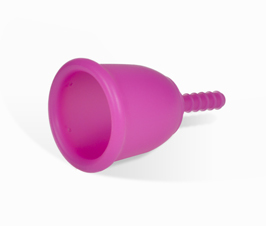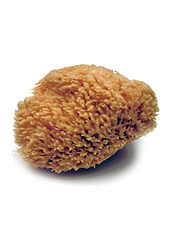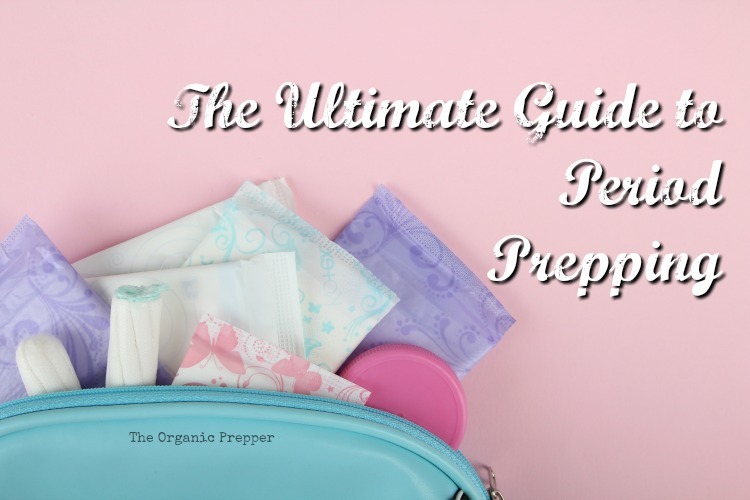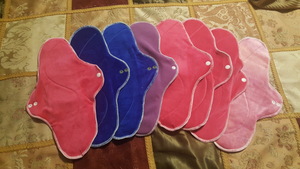If you're new here, you may want to subscribe to my RSS feed. Thanks for visiting!
Ok, I get it. This is an uncomfortable topic for lots of preppers. Periods are often seen as too impolite to discuss. Considering that periods affect 50% of the population, odds are either you or someone you love will get periods. Unless your plan for SHTF is to live in an all-male testosterone-factory, menstrual periods are going to impact you in some way. So, let’s prep for that.
Crash Course in Periods
For those who may be lacking in period knowledge, let’s shed a little light on this on this taboo topic.
Once a month, healthy women from ages twelve to fifty experience menstruation. The uterus builds up a lining in preparation for a potential pregnancy. If there is no pregnancy, the body sheds this excess material. This process takes approximately 28 days, or one lunar month, give or take a few days depending on the individual woman.
The shedding of this material is known as the menses or menstrual flow. There is a small amount of blood which colors this material. Even though blood is only about a third of the menstrual flow, a woman can still become tired, or even anemic, during menstruation.
This flow lasts between four to seven days. Unfortunately, periods can be preceded and accompanied by some uncomfortable symptoms, like bloating, cramping, headaches, and irritability. When these symptoms are severe, they can be indicators of underlying health problems.
Irregular Periods
There are a number of scenarios that can lead to missed periods, or periods stopping altogether. Some of these causes are healthy and normal. Others may indicate a health concern.
Some reasons for missed or stopped periods include:
- Youth (the first couple of years can be erratic)
- Pregnancy
- Lack of nutrition
- Excessive weight loss
- Excessive weight gain
- Excessive physical activity/exertion
- Illness
- Medications
- Hormone-based birth control
- Hormonal imbalance
- Menopause
- Trauma/stress
On the flipside, excessive bleeding and too frequent periods can also be an issue. The causes for these are often more serious than missing or stopped periods.
Some causes for excessive or too frequent periods are:
- Hormone imbalance
- Endometriosis
- Fibroids
- Polyps
- Intrauterine devise (IUDs)
- Pelvic inflammatory disease
- Some sexually transmitted diseases (STDs)
- Certain types of cancers (uterine, cervical, or ovarian)
Keeping Track of Periods
Since irregular periods can indicate significant health changes, it is important to keep track of your periods. Use a calendar to record when your periods start and stop each month. After a few months, you will see a pattern.
This tracking will tell you a number of things. How many days are there between each period starting? That’s the length of your cycle. This should be about 28 days long, give or take a few days. This calendar keeping will also show you how many days your period lasts. This will likely be between 4 to 7 days.
This kind of tracking is important healthcare information. If you are acting as your preparedness group’s health care go to person post-SHTF, you will want to ask the women who come to you when the date of their last period was (the date when it started) as part of the normal intake.
You will also ask if their cycle has been normal. Have there been any skipped periods? Are they bleeding between periods? Are periods heavy or lasting longer than a week? These questions can tell you a lot about a woman’s health.
Why is good feminine hygiene important?
Poor feminine hygiene can lead bacterial and fungal infections. Urinary Tract Infections (UTIs) are very common in disaster areas due to both a lack of good hygiene and stress. Unsanitary practices can cause Reproductive Tract Infections (RTIs), which can lead to both infertility and cancer.
These are the kinds of illnesses often seen in third world conditions, or in places that have suffered a natural disaster. In India, 70% of women said they cannot afford sanitary pads and other period products. As a consequence, girls do not leave the house during a period and often miss out on an education.
For preppers, we need to be mindful that periods will still happen after a disaster. We don’t want to get sick, and we don’t want our movement restricted. Both of those would make us vulnerable during a crisis.
Feminine Hygiene for Preppers
While most of us are familiar with the disposable products on the market, we do have other options. They each have their pros and cons. Some may work great for one woman but be terrible for another. So, let’s take a look at each so you can make the best decision for your preps.
Disposable Sanitary Pads
These are the most familiar period products out there. These pads are often made from bleached cotton, and sometimes have other materials to maintain dryness and odor control. Disposable pads are used by women all over the world. They also serve a dual purpose to absorb blood from a bleeding wound. Many preppers are already stocking them for wound care, especially the extra large, postpartum pads. They can be purchased in quantity at big box stores, as well as wholesale clubs.
They can, however, leave you feeling like you are wearing a diaper. Disposable pads frequently cause chafing at the groin and thighs, which would be a real problem during a bug out on foot. Disposable pads also present a waste problem post-SHTF since you can bet trash removal services won’t be available. I suppose you could bury or burn them if you were on the move. But, if you are bugging in, how high of a trash pile do you want in your backyard? And do you really want blood in your trash pile which will attract rodents and larger four-legged critters?
Many women find these products trigger a burning sensation in the tissues that touch the pad. This burning may be caused by the chemicals used in the pads. Organic cotton pads are available, but some of these tend to break apart and make a mess.
Tampons
Tampons are another familiar, convenient, affordable form of period product. A cotton plug is inserted into the vagina which absorbs the menstrual flow and prevents leaks. This cotton plug has to be removed at least every 8 hours, preferably sooner. There is a string attached for easy removal. Many preppers already stock these in case of gunshot wounds.
Leaving tampons in longer than 8 hours can lead to toxic shock syndrome. Toxic shock syndrome is a reaction to toxins released by the Staphylococcus aureus and group A streptococcus bacteria. This is a serious condition that can lead to renal failure and death. Toxic shock syndrome is rare these days, as more women are aware of the risks.
Tampons also are associated with the same burning sensation that many women experience with disposable pads. Organic cotton tampons are available and do not produce that irritating burning feeling.
As far as disposal, if the tampon has a plastic applicator, you still have trash to deal with. Some come with cardboard applicators that you could burn or bury. Others have no applicator. They all typically have some time of plastic wrapper.
Menstrual Cups

They do have a learning curve when it comes to insertion and removal. If a cup is uncomfortable, a different size or even a different brand may be a better fit.
Diva Cup is one of the more well-known brands. But, there are many more brands on the market today now that the menstrual cup is becoming more common. This is a very popular solution for preppers.
Cloth Pads
Just as there have been huge improvements to cloth diapers, cloth pads have come a long way. Today’s pads come in an array of comfortable (great!) and colorful (why?) fabrics. Some have the same waterproof PUL backing to prevent leaks and charcoal-infused bamboo cloth (find them here) and others are made with cotton flannel and cotton fleece. Some are made with organic fabrics.
My favorite happen to come from an Etsy seller from Canada, MomsCrafts4U. These recently arrived to add to my stash. I didn’t want to invest in a lot of pads until I found some that I really liked.
Of course, if you’re crafty, you can always sew your own. You can find free cloth pad patterns from Luna Wolf, Diaper Sewing, and Hillbilly Housewife. It is a great use for old, flannel shirts that are too worn to donate.
Cloth pads have wings with snaps that secure around the underwear. When it’s time to change them, you can put them in what’s called a “wet bag” (a bag commonly made of PUL that won’t leak), or into the wash.
And that is the drawback. Cloth pads need to be laundered. That’s not a big deal if you are bugging in. But, if you are bugging out, it could be.
Menstrual Sponge

For women who have very sensitive tissue, this may be the perfect solution. They are also non-toxic and sustainable. Divers cut the sponge leaving enough for the sponge to grow back.
The drawback would be that unless you are an ocean diver with access to sea sponges, there would be no resupply available in an SHTF scenario. However, they are available for a song from Bulk Apothecary. Anyone could easily stock up on these the same way they stock up on powdered milk or ammunition.
Is Organic Really Necessary?
A lot of organic and non-toxic menstrual products are now on the market. Of course, they tend to be more expensive. You may be wondering if it’s really worth the extra cash.
If I were stocking up disposable pads and tampons for wound care, which I do, I don’t really care if they are organic or not. Any exposure to potentially harmful substances is minimal, restricted to however long it takes to stop the bleeding.
For women to put next to our bodies, I do think it’s worth the added expense. The tissues involved are delicate, permeable, and absorbent. Regular disposable pads and tampons have adhesives, perfumes, dioxins, BPA, and phthalates. These chemicals are linked to an array of health problems from birth defects to heart attacks to cancer. Just check this one article about BPA risks alone. They are suspected to be the cause of the burning sensation many women report when using disposable pads and tampons.
It is also interesting to note that women who switch to non-toxic menstrual products often say their cramping and other period symptoms improve. This article on how cloth pads “saved” the author from Be Prepared Period details a dramatic improvement just by switching.
What About Feminine Washes and Douches?
These are entirely unnecessary, even after a period. There are some truly ridiculous fears and beliefs surrounding periods, none of them based in fact.
You don’t need to smell like spring rains or botanical gardens. You can actually do yourself more harm than good with excessive washing and douching. Other than a gentle soap and water, you don’t need anything else to get clean after a period.
Occasional douches have a place, however, when there is an infection. A douche is one way to bring herbal medicine directly to the affected tissues. However, douching should not be a regular practice. It certainly shouldn’t be done just to add some fake perfume of white lilies. Regular douching is associated with bacterial vaginosis, pelvic inflammatory disease, pregnancy complications, and cancer.
What to Use When
Each of these products has their pros and cons. Out of the above options, I use three of them in my preps. Here is a quick summary of what I store and why.
- Disposable pads and tampons: I keep these on hand for wound care. They absorb the blood while you apply pressure to the wound.
- The menstrual cup: This goes in the bug out bag. It can be emptied, easily cleaned and reused, and the fluid can be buried like any bodily waste.
- Cloth pads: These are great for both every day use and long-term “bugging in”. They are sustainable and will last through years of periods.
While there is a lot more that could be said about women’s reproductive health and the peaks and valleys of the menstrual cycle, this guide should give you a better idea for how best to manage your periods post-SHTF.
Have a suggestion I missed?
Let me know in the comments.

















8 Responses
Endometrial ablation surgery (outpatient) is the answer, will stop periods and a good permanent form of birth control which is ideal when you wouldn’t want to bring kids into this whacked out world today, esp if shtf. I am way past menopause , never got the surgery. Get a referral to a specialist, and you may want to tell Dr. that you are planning to live “off grid” and don’t want the hassle of periods and no kids (or any more kids).
Thank You. I need this. I am so done having kids. I’ll have to find a doc willing to do it. My current doc laughed at me when I asked for a hysterectomy, even though another pregnancy could end my life. My husband was there and asked for it with me. I need to find an atheist doc who doesn’t actually have the nerve to say to a known atheist patient, “but if it’s god’s will…” about more kids being unwanted. My kids except one are all adults and my youngest is 15. Now I’m just waiting for grandkids from the adult ones.
The doctor didn’t refuse because of religious beliefs, he is avoiding a potential malpractice lawsuit. His insurance carrier would probably drop him if he were to perform medically unnecessary operations.
Great article and great advice. I’ll probably be getting a cup soon, as it fits my lifestyle best, backed up by a few sponges. I like natural sponges for art, so why not for this?
I would advise a bit of caution however. I followed the link to the article at Be Prepared Period, and it really seemed scammy to me. I noticed a lot of sensationalist word choices and it was after all written on a site that sells disposable pads. Now it’s possible that the author had a bad allergy to some component in the products she was using, but colorful testimonials like that cause my BS detector to start registering.
That said, thank you for the information and advice!
Correction, I should have said “reusable” not “disposable” above. Apologies.
So glad that you did a post on this. Sometimes I think about the little things that will make women and infants/children’s life more bearable during shtf, and menstruation products are totally up there.
Another girly product that I think will be in high demand for females are ponytail holders!!! I know when I can’t find one it drives me nuts and a pencil will do short term but I need my hair secure sometimes.
Also, as far as menstrual cups go, you mentioned there is a learning curve and I would say so. A couple years ago I tried using one….I even bought a little pot to boil and sanitize it and (thought) I washed it out so well between emptying it, but I feel like it made me vulnerable to uti infections. TMI…one time it suck up high in there and was sooooooooo painful and difficulty to remove….so unloved the concept on paper but not in action.
————————————————-
RE: “Many preppers already stock these in case of gunshot wounds.”
Please reconsider using tampons for gunshot wounds. On the one hand, you might believe they’d be perfect since the can be slipped into a gunshot wound and expand.
The reality is that gunshot wounds typically take far more absorbing power in a few minutes than a tampon can provide. Consider that such a wound might take 1 or 2 or 3 lengths of 6 feet of gauze packed into the wound plus an Israeli bandage on top of that.
Please see this short video by SkinnyMedic for a professional’s opinion.
https://youtu.be/Nf_PPQOrKIc
Obviously this is important to those for whom it is important. But- they clearly are not 50% of the population. Since most women stop menstruating at age 50 or thereabouts, and then live to age 80 or more, and since older people are an increasingly greater percentage of the population,(due to the reluctance of many people to have more than one or two children, or any at all), it is clear that far fewer than 50% of the population menstruates.